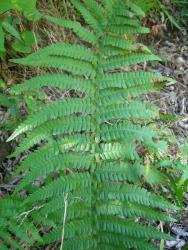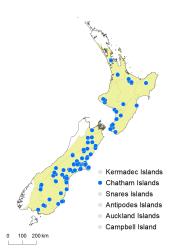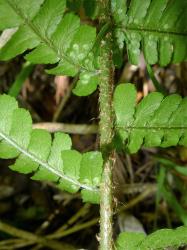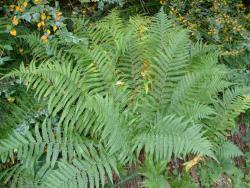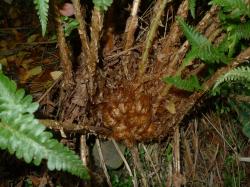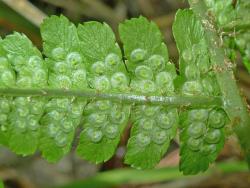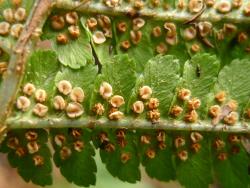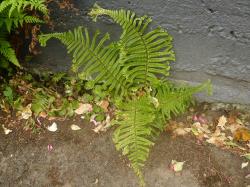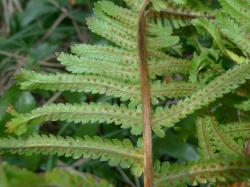- Taxon
- Weed
- Gallery
- ≡ Polypodium filix-mas L., Sp. Pl. 1090 (1753)
Rhizomes erect, densely scaly. Rhizome scales ovate, 7–25 mm long, 2–5 mm wide, pale brown, concolorous, margins entire. Fronds 240–1190 mm long. Stipes 40–420 mm long, pale brown, densely scaly, especially near the junction with the rhizome; scales ovate, pale brown, up to 30 mm long and 7 mm wide. Rachises pale or yellow-brown, sulcate, narrowly winged distally, scaly; scales scattered throughout, ovate, pale brown, up to 4 mm long and 1 mm wide. Laminae 2-pinnate at base, elliptic or narrowly elliptic, 200–880 mm long, 95–340 mm wide, mid-green on both surfaces, herbaceous, bearing scales on both costa surfaces and the abaxial lamina surface. Primary pinnae in 17–38 pairs below pinnatifid apex, widely spaced especially proximally, narrowly ovate or narrowly triangular or narrowly elliptic; the longest at or near the middle, 50–180 mm long, 13–38 mm wide, apices acute or acuminate, bases stalked; costae narrowly winged throughout, not dark at junctions with rachis when fresh. Secondary pinnae decreasing gradually in length along the primary pinna to the distal end, or sometimes longest at mid-pinna; the longest secondary pinnae oblong, 7–23 mm long, 3–7 mm wide, apices obtuse or rounded, margins toothed especially at the apices, bases adnate. Sori on distal primary pinnae only, round, in 1 row either side of costa, nearer costa than margin; indusia reniform, flat when young, 0.8–1.2 mm diameter, concolorous, glabrous.
Dryopteris filix-mas is recognised by its erect rhizomes with pale brown scales, abundantly scaly stipes and rachises, 2-pinnate laminae, secondary pinnae of uniform size, basal basiscopic secondary pinnae on the lowermost pair of primary pinnae not extended, and sori confined to the distal half of the lamina. It is very similar to D. affinis but differs in that the stipe is less abundantly covered in pale brown rather than golden brown scales, and in having slightly overlapping and wider primary pinnae (17–38 mm wide, cf. 18–25 mm wide), more crowded secondary pinnae with obtuse or rounded rather than truncate apices, and indusia that are flat when young rather than inrolled. In living plants the costae of the primary pinnae are not darkened at the junctions with the rachis.
Cultivars with crested pinna apices are known to occur occasionally in the wild. Most of these are referable to ‘Cristata’ (e.g. CHR 065932, Motu Bush, Gisborne; AK 225551, Rakaia Gorge) but a few with very narrow pinnae (e.g. AK 284228, CHR 526478, Riccarton, Christchurch) are ‘Linearis Polydactyla’ (Hoshizaki & Moran 2001).
North Island: Auckland, Volcanic Plateau, Gisborne, Taranaki, Southern North Island.
South Island: Sounds-Nelson, Marlborough, Canterbury, Westland, Otago, Southland.
Chatham Islands.
Altitudinal range: 0–1580 m.
Dryopteris filix-mas is widely distributed in the North Island from Auckland to Wellington, and in the South Island from Nelson to Foveaux Strait. It is particularly well established and spreading east of the main divide in Marlborough, Canterbury and Otago. In the North Island it ranges from near sea level, up to 900 m near Dawson Falls, Mt Taranaki. In the South Island it reaches 1580 m in the Two Thumbs Range, Canterbury. It also occurs on the Chatham Islands.
Occurs naturally in North America, Europe, Asia and North Africa (Tutin et al. 1964; Smith 1993; Roux 2009).
Dryopteris filix-mas grows under kānuka, broadleaved forest, scrub, introduced Acer, Larix, Picea, Pinus, Pseudotsuga and Salix species, and in open grassland. It favours tracksides, roadside verges, banks, river terraces, gullies, drains, boulder fields, rotten logs, and dune hollows. It also grows in urban environments on brick or block walls, on concrete, along fence lines, and on waste ground.
Healy (1958). Voucher CHR 71623, 1951.
Dryopteris ×tavelii Rothm., the hybrid between D. affinis and D. filix-mas, has been recorded from the Rakaia Gorge, Canterbury (WELT P023374–023378; CHR 616781) and from Dunedin (WELT P011737–011738).
No chromosome count has been reported for New Zealand plants. In Europe the plant is known to be an allotetraploid sexual species derived from D. caucasica and D. oreades (Page 1982).



